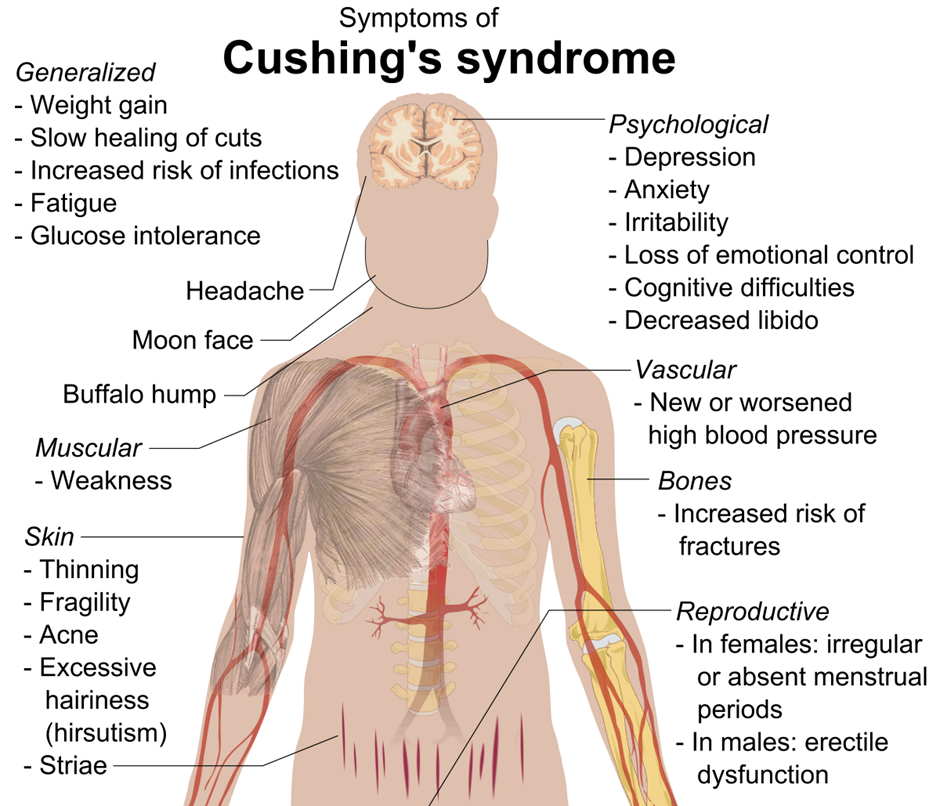A nurse is collecting data from a client who has Cushing's syndrome. Which of the following findings should the nurse expect?
Jaundice
Muscle rigidity
Weight loss
Easily bruised
The Correct Answer is D
Choice A Reason:
Jaundice, characterized by yellowing of the skin and eyes, is typically associated with liver dysfunction or conditions affecting the breakdown of red blood cells, not directly linked to Cushing's syndrome. While some liver abnormalities can be seen in Cushing's syndrome due to metabolic changes, jaundice is not a typical manifestation of this condition.
Choice B Reason:
Muscle rigidity is more commonly associated with conditions like Parkinson's disease, dystonia, or certain muscle disorders. In Cushing's syndrome, muscle weakness due to protein breakdown and muscle wasting is a more expected finding rather than muscle rigidity.
Choice C Reason:
Weight loss is incorrect. Weight gain, particularly in the central part of the body (trunk) and face (creating a "moon face"), is a more common characteristic of Cushing's syndrome. The excess cortisol often leads to increased fat deposits, especially in these areas, rather than weight loss.
Cushing's syndrome is characterized by an excess of cortisol in the body, either due to the body producing too much cortisol or from long-term use of corticosteroid medications. Considering this condition, the nurse should expect the following finding:
Choice D Reason:
Easily bruised is correct. Excess cortisol can lead to the thinning of the skin and weakening of blood vessels, making individuals with Cushing's syndrome prone to easy bruising. Other common findings associated with Cushing's syndrome include weight gain (especially in the trunk and face), muscle weakness, high blood pressure, fatigue, and changes in skin such as thinning and purple stretch marks.

Nursing Test Bank
Naxlex Comprehensive Predictor Exams
Related Questions
Correct Answer is ["A","C","D"]
Explanation
Choice A Reason:
Maintaining skin integrity over the blisters is correct. Blisters form as a protective mechanism for the skin underneath. Popping or breaking blisters increases the risk of infection as it exposes the raw skin to bacteria and other contaminants.
Choice B Reason:
Applying ice to the larger blisters is incorrect.
Reason: Applying ice directly to a burn, especially to blisters, can further damage the skin and exacerbate the injury. Ice can cause additional skin damage and can potentially increase pain and delay healing.
Choice C Reason:
Administering ibuprofen for pain is correct. Ibuprofen is an effective over-the-counter pain reliever that can help manage the discomfort caused by a minor burn. It also has anti-inflammatory properties that can reduce swelling associated with burns.
Choice D Reason:
Running cool water over the affected area is correct. Running cool (not cold) water over the burn helps to cool down the burned area, soothes the pain, and helps prevent further damage to the skin. It's recommended to run water over the burn for around 10-15 minutes to effectively cool the area.
Choice E Reason:
Allowing the affected area to remain open to air is incorrect. Keeping a minor burn uncovered can increase the risk of infection as it exposes the burn to external contaminants. Covering the burn with a sterile, non-stick dressing can protect it from further damage and reduce the risk of infection.
Correct Answer is A, B, C, D, E
Explanation
Whether you are a student looking to ace your exams or a practicing nurse seeking to enhance your expertise , our nursing education contents will empower you with the confidence and competence to make a difference in the lives of patients and become a respected leader in the healthcare field.
Visit Naxlex, invest in your future and unlock endless possibilities with our unparalleled nursing education contents today
Report Wrong Answer on the Current Question
Do you disagree with the answer? If yes, what is your expected answer? Explain.
Kindly be descriptive with the issue you are facing.
